When it comes to bringing professional studio quality into your home, the Apollo Twin Universal Audio device stands out like a star.
This powerful audio interface captures every nuance of sound with pristine clarity, letting users create music that sounds just as crisp and vibrant as their favorite tracks.
You might wonder why this compact device is a go-to for musicians and producers worldwide. Its seamless audio conversion and exceptional sonic detail are the secret behind many chart-topping hits, making Apollo interfaces a favorite among professionals.
Let’s discover its features and see how this audio magic box can elevate your sound production.
Introduction
What is the Apollo Twin Universal Audio?
The Apollo Twin Universal Audio is a high-end audio interface designed for professional musicians, producers, and engineers. This 2-channel interface stands out for its exceptional sound quality, low latency, and advanced features, making it an ideal choice for recording, mixing, and mastering music.
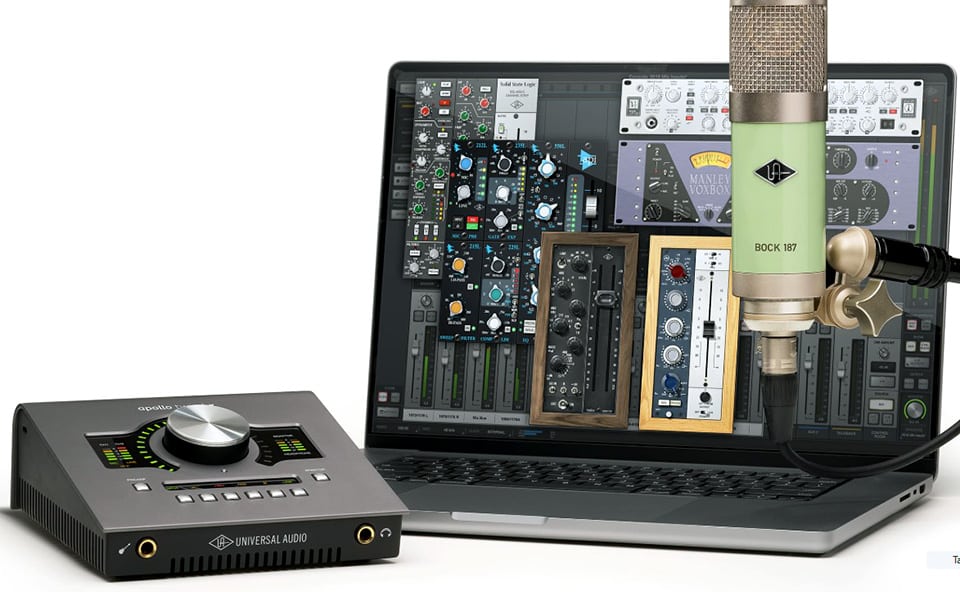
As part of the renowned Universal Audio Apollo series, the Apollo Twin combines the best of analog and digital technologies to deliver unparalleled sound quality. Whether you’re working in a home studio or a professional environment, the Apollo Twin interface ensures that your recordings are crisp, clear, and vibrant, capturing every nuance of your performance.
Universal Audio Apollo Twin MkII

PERFECT FOR: all recording needs
FEATURES: Desktop 2x6 Thunderbolt audio interface for Mac and Windows with next-generation 24-bit/192 kHz audio conversion
OTHER INFO: Single UAD DSP Processor for optimal processing power and audio performance
Universal Audio Apollo Twin MkII
- Unison™ technology offers stunning models of classic tube and transformer-based preamps, guitar amps, and stompboxes
- Built-in talkback mic for communication with studio talent and recording slate cues
- Runs UAD Powered Plug-Ins via VST, RTAS, & AAX 64 in all major DAWs
- Uncompromising analog design, superior components, and premium build quality
- Comes at a higher price point than some of its competitors
When you click ‘Check Price’, you’ll see there are loads of great places to buy this item. Our personal favorite is Sweetwater for the US, and Thomann and Gear4Music for the UK & Europe.
They are the largest music retailers, with excellent customer service, competitive prices, really fast shipping, and the longest guarantees.
The professional musician who wrote this article combined many things,
from the product build, manufacturer’s reputation through to feedback
from other users, to create our famous TedScore™.
Design and Connectivity
Thunderbolt and USB Connectivity
When it comes to connectivity, the Apollo Twin series offers both Thunderbolt and USB options. Apollo Twin X shines with its Thunderbolt 3 capability, ensuring high-speed data transfer and low latency.
This makes it ideal for professionals seeking precision and efficiency in their workflow.
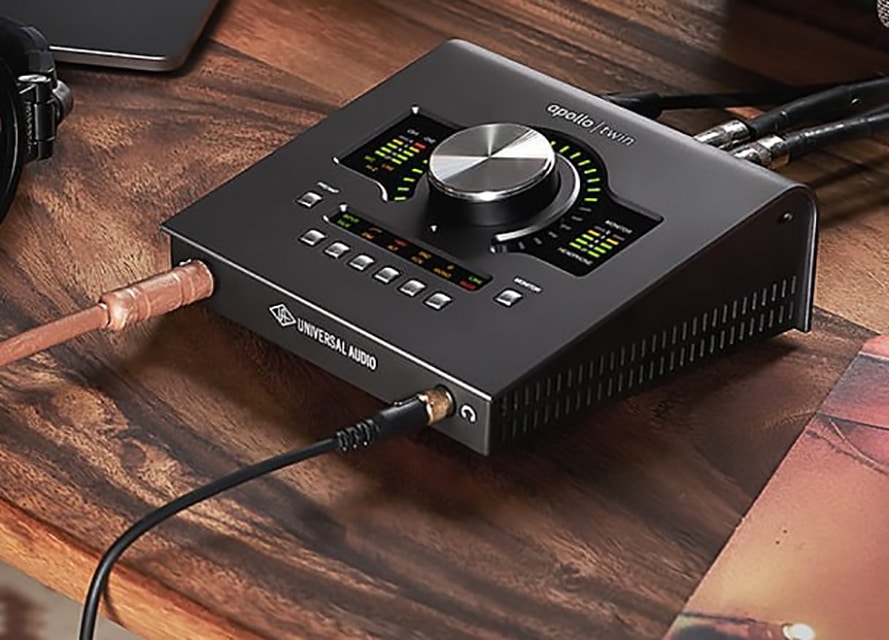
For those using Windows or prefer USB, Apollo Twin USB provides a dependable alternative. It supports seamless connectivity across different systems. Thunderbolt 2 versions also exist, expanding compatibility with older setups.
Thunderbolt and USB Connectivity
The Apollo Twin’s design is a hallmark of simplicity and functionality.
Its desktop-friendly form makes it a popular choice for home studios and professional environments alike.
Every detail, from its quality knobs to its robust build, speaks to Universal Audio’s commitment to excellence. I appreciate how the controls are intuitive and accessible, allowing for quick adjustments during sessions.
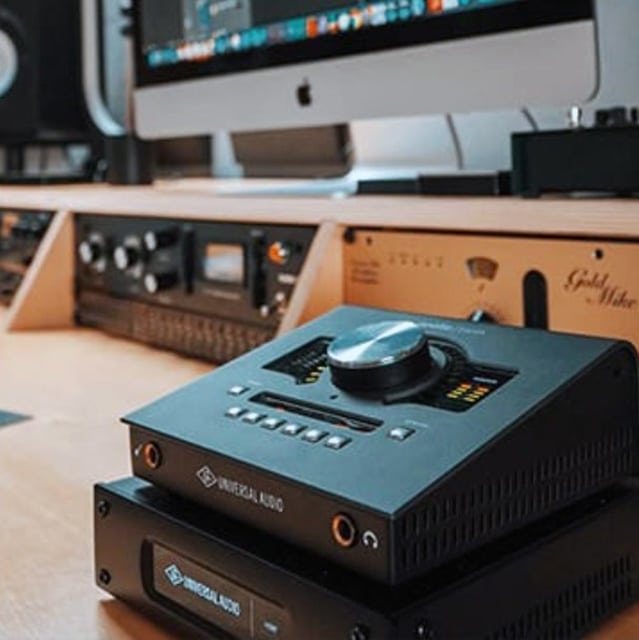
Overall, the understated elegance paired with practical design elements creates a user-friendly experience that enhances both aesthetics and usability.
Audio Quality and Conversion
The Apollo Twin audio interfaces are known for their outstanding audio conversion and unique Unison technology. With analog sound and high dynamic range, they offer a remarkable listening and recording experience.
A/D and D/A Conversion
Apollo’s A/D and D/A conversion technology stands out, providing vivid audio clarity. The analog-to-digital (A/D) conversion ensures that every nuance of the original sound is captured accurately, and digitally analog (D/A) conversion delivers a warm, natural playback experience. With a high dynamic range, the sound is both broad and rich, mimicking that classic analog feeling with precision.

The enhanced conversion offers an exceptional level of detail, making it ideal for professional recordings. From subtle audio shades to powerful dynamics, these converters keep the integrity of the sound intact, making sure that nothing gets lost in translation. It’s all about delivering pure and honest sound.
Unison Preamp Technology
Unison Technology is another exciting aspect of the Apollo Twin. This game-changing feature lets me emulate renowned mic preamps, including the legendary 610-B Preamp.
By integrating the impedance and gain stage, it replicates the character of classic analog gear, delivering a distinctly authentic tone.

This technology doesn’t just simulate the sound but recreates the entire electronic path of legendary equipment. It grants me the power to infuse recordings with that rich, vintage quality, whether I’m using a classic mic or a modern
Realtime Processing and Plugins
When I talk about the Apollo Twin series, two standout features come to mind: its real-time processing capabilities and the exceptional bundle of UAD plug-ins. These aspects transform the Apollo Twin into a powerful tool for capturing classic analog sound with modern ease. Features like Auto-Gain simplify the audio mixing process by automatically adjusting levels to optimize sound quality.
Realtime UAD Processing

The Apollo Twin’s real-time UAD processing allows me to record and mix with near-zero latency.
This is crucial for handling performances without the distraction of delay.
It’s like bringing a vintage studio experience to the desktop
The Console 2.0 application plays a key role here. It offers meticulous control over signal routing and configuration, ensuring everything runs smoothly. This makes it possible to use high-quality plug-ins like those emulating analog giants Neve and Manley.
Bundled UAD Plug-ins
The bundle of UAD plug-ins, including the Realtime Analog Classics suite, is a significant advantage. It offers authentic emulations of legendary hardware. The collection features the famous Teletronix LA-2A and 1176 compressors, known for their rich tonal characteristics and versatility.
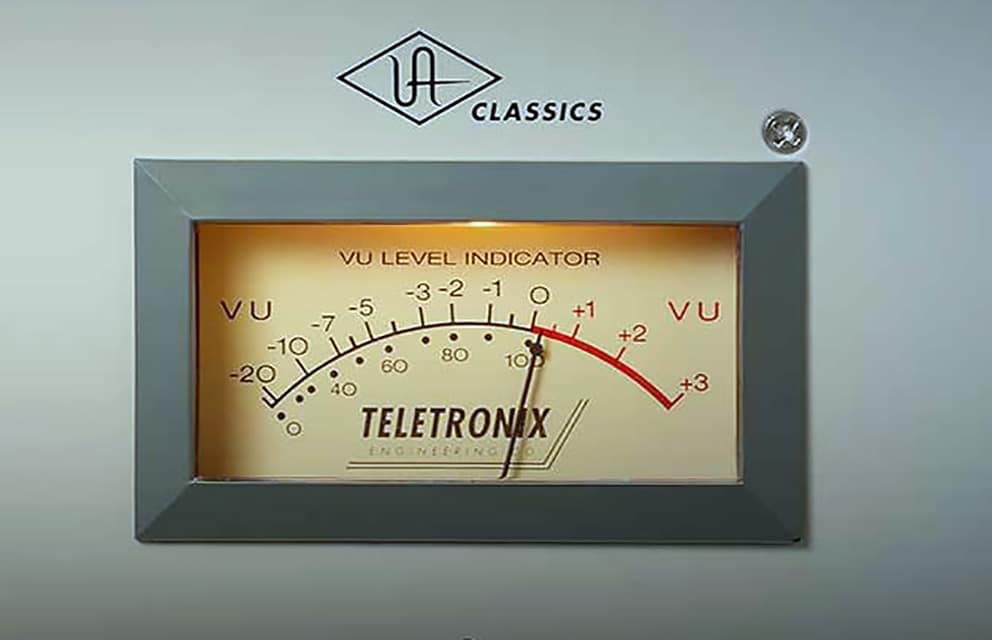
Each plug-in is carefully designed to capture the essence of vintage sound. Notably, the Pultec EQs provide the classic warmth and clarity of analog EQs. These tools are invaluable in crafting a mix of depth and character reminiscent of the golden era of recording.
Compatibility and Integration
The Apollo Twin Universal Audio interfaces are renowned for their seamless integration in professional and home studio environments. They offer versatile software compatibility and robust cross-platform functionality.
Software and DAW Integration
When using an Apollo Twin with music production software,
I appreciate its compatibility with major DAWs like Pro Tools and Logic Pro. VST and AAX plugins work effortlessly, allowing me to utilize a wide range of effects and instruments.

One powerful feature is the UAD DSP Acceleration, enhancing mixing and tracking by offloading processing power. The integration with Unison Preamps transforms the interface into classic preamp models, such as the UA 610-B Tube Preamp or Marshall Plexi Classic Amplifier, providing rich tones for guitars and vocals. These tools contribute to low-latency monitoring and optimal sound quality.
Cross-Platform Functionality
With Mac and Windows support, the Apollo Twin fits into any studio setup. Its Thunderbolt Audio Interface ensures swift data transfer and low latency, making live monitoring a breeze.
I find the inclusion of 24-bit/192kHz audio resolution essential for producing high-quality recordings.
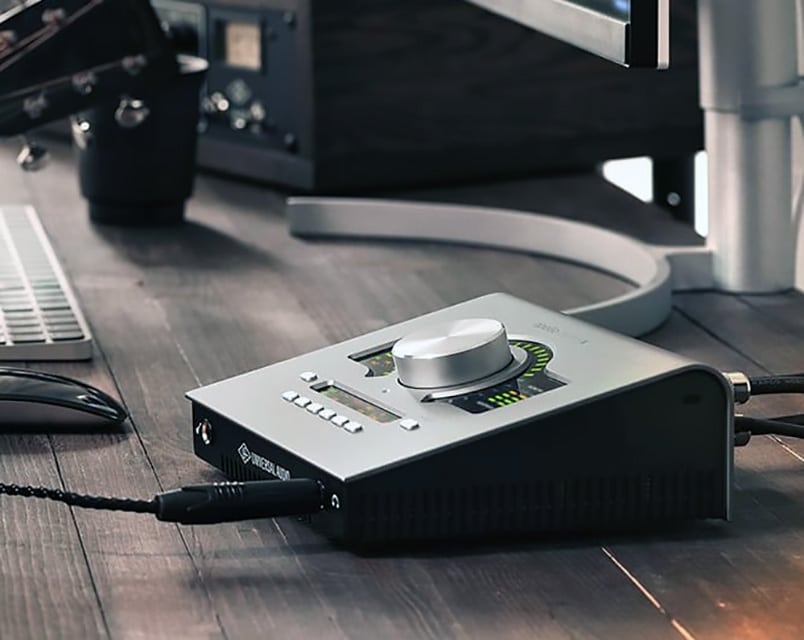
The interface’s Onboard DSP allows real-time application of tape machines, vintage amps, and channel strip presets. The Headphone Output is ideal for detailed monitoring during sessions. Whether recording with a Marshall Plexi Super Lead 1959 or mixing with top-notch equalizers, the Apollo Twin’s cross-platform functionality and advanced features keep my workflow uninterrupted.
Performance and Testing
Evaluating Sound Quality and Latency
The Apollo Twin Universal Audio has undergone extensive testing to ensure it meets the highest standards of sound quality and latency. Users will be pleasantly surprised by the clarity, depth, and detail it delivers, making it suitable for a wide range of applications, from recording and mixing to mastering and post-production.

The interface’s onboard DSP (digital signal processing) allows for low-latency processing, which is crucial for real-time monitoring and tracking.
In terms of latency, the Apollo Twin excels with a latency of around 1.2 ms, significantly lower than many other audio interfaces on the market. This ultra-low latency makes it possible to record and mix music in real-time without any noticeable delay or lag, ensuring a seamless and professional recording experience. Whether you’re handling large sessions or intricate mixes, the Apollo Twin’s performance will not disappoint.
Real-World Applications
Home Studio and Professional Use Cases
The Apollo Twin Universal Audio is a versatile tool that fits seamlessly into both home studios and professional recording environments. In a home studio setting, the Apollo Twin can be used for recording and mixing music, podcasting, and voice-over work. Its compact size and portability make it easy to take on the go, making it an ideal choice for musicians and producers who need to work on location.

In professional studios, the Apollo Twin shines with its high-quality sound and low latency, making it perfect for critical listening and mixing applications. Its advanced features, such as the onboard DSP and UAD plug-ins, make it suitable for complex mixing and mastering tasks. The Apollo Twin’s ability to emulate classic analog gear through its Unison technology and UAD plug-ins provides a rich, vintage quality to recordings, bridging the gap between old-school warmth and modern precision.
Overall, the Apollo Twin Universal Audio is a powerful and flexible audio interface that caters to a wide range of applications. Its exceptional sound quality, low latency, and advanced features make it an indispensable tool for musicians, producers, and engineers who demand the best from their recording equipment.
Apollo Twin Universal Audio
Final Thoughts
The Apollo Twin interface stands out for its impressive capabilities, especially with its quad-core processor that handles large sessions with ease.
Many users are pleasantly surprised by the warmth and clarity it brings, reminiscent of a classic analog console. With features like Apollo Monitor Correction, it ensures accurate sound reproduction, making it easier to achieve professional-quality mixes.
This interface is a favorite among musicians and producers who appreciate the reliability and performance of Apollo interface in their recording setups.
Here’s a nifty breakdown of its standout points:
Sound Quality: High-level A/D converters deliver a warm, dynamic range.
Compatibility: Supports a variety of software and platforms, which is essential.
Design: Portable yet durable, a great companion for on-the-go projects.
Additionally, the Apollo Twin X offers Thunderbolt 3 connectivity, providing faster speeds and improved performance. Having tested it alongside the Twin, I appreciate the advancements it brings to the table.
Although the price might be a concern for some, the value it offers in performance and reliability justifies the investment. With universal compatibility and unmatched audio clarity, it remains a favored choice in my recording arsenal.
For anyone in the market for a top-tier audio interface, exploring the Apollo Twin models would be worth the time and consideration. They certainly deliver professional-grade sound.
Don’t go yet…
Discover the top choices for professional audio interfaces in our article “Best Professional Audio Interface Revealed,” where we break down the features and benefits of each option to help you find the perfect fit for your recording needs!
FAQ's
Universal Audio Apollo is a high-quality audio interface that provides professional-grade recording, mixing, and processing capabilities with built-in DSP for real-time effects and low-latency monitoring.
No, the Apollo Twin requires a computer to function, as it relies on software for recording and processing audio.
The main difference between the Apollo Twin and Apollo Twin MkII is that the MkII features improved converters, enhanced DSP processing power, and additional connectivity options, making it more versatile for professional audio applications.
To connect your Apollo Twin to your computer, simply use a Thunderbolt cable to connect the Apollo Twin to a Thunderbolt port on your computer.










